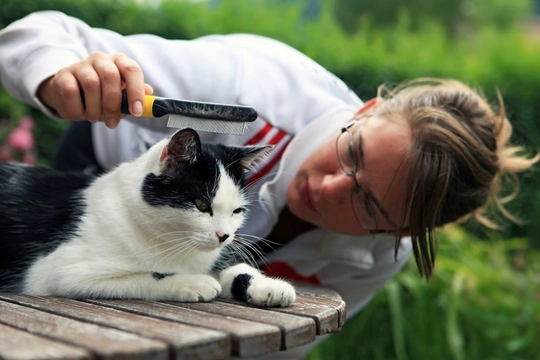
Would you know if your cat had fleas?
When it comes to fleas, most cat owners are very firm on the idea that their cat does not have fleas and that they would know all about if they did, and anyway, their cat cannot have fleas, because they are treated with a good quality flea treatment product every month-end of story!
However, when it comes to fleas, cats and their owners, it is not always as obvious as you might think it would be when cats do have fleas, and it is entirely possible that your cat could be quite badly infested with them and you might not even know.
In this article, we will explain why it is not always as simple as you expect it to be to tell if your cat has fleas, and some of the best ways in which you can find out if they do. Read on to learn more!
Why might you not realise that your cat has fleas?
There are two common misapprehensions made when it comes to cat owners and fleas: the first is that you flea treat them regularly to protect against fleas then they simply won’t have any, and the second is that it would be self-evident if your cat was carrying fleas, because you too would be getting bitten by them!
However, these two things are by no means guarantees, because certain flea treatment products, even good quality ones from your vet, can lose effectiveness over time. In some areas of the country, some flea treatment products are essentially as good as useless, and there is no way that you will know this before buying-until you see the evidence of fleas on your cat after treatment!
Secondly, the majority of cat owners assume that if their cat had fleas then they too would be getting bitten, but this is not the case. While we used the name “flea” as a catch-all title, there are actually numerous different flea species, and some of them are species-specific when it comes to the types of animal that they will feed from-which means that cat fleas are highly unlikely to bite people, even if your cat is lousy with them, and being bitten to distraction themselves!
Finally, you might also assume that you would be able to see fleas on your cat if they had more than a couple of them, and that if you cannot see any fleas, your cat is ok. But fleas live very close to the skin, as they do of course need to bite it in order to feed. This means that fleas, flea eggs and juveniles will all be right on the surface of your cat’s skin, not distributed throughout the fur, and so unless your cat is white, you probably won’t be able to see fleas with ease unless you go through their coat with a flea comb, as even parting the hair is not very effective.
Some simple ways to tell if your cat does have fleas
So now that we have established some of the common pitfalls and misapprehensions surrounding how you might miss noticing that your cat has fleas; how can you actually tell for sure? There are a few reliable methods that you should try out, and repeat every couple of months too, just to make sure!
Firstly, invest in a flea comb: a flat, wire-toothed comb with the tines close together. Flea combs get right down to the roots of your cat’s fur, and when you comb out their fur, fleas get caught in the tines of the comb and are visible when you examine it. Five minutes of carefully and gently combing out your cat’s coat will almost certainly produce a few fleas, if there are any to be found.
Your flea comb can also be helpful in identifying signs of fleas, even if it does not pick up any fleas itself. If, when you comb out your cat’s fur, you find a lot of tiny black or dark specks in the comb, this may be juvenile fleas and flea dirt, but it may also potentially be simple dust and dirt that is not related to fleas.
In order to tell the difference, knock the contents of the comb (the black dirt) onto a clean white piece of paper, fold the paper over, and crush the paper-when you open it up, if there are tiny smears of blood, you have found evidence of fleas, while if the black spots are simply black spots, your cat is likely flea-free.
Finally, an interesting if rather gross way to tell if you have fleas in your home or on your cat involves a little creativity! You will need a shallow bowl of water with washing up liquid in it, an angled desk lamp, and a dark room. Set the bowl up directly under the light and leave it overnight-placing it in a room where your cat sleeps or spends a lot of time is best-and in the morning, you may well find the bodies of a selection of fleas in the water!
Fleas are drawn to the light source and then fall into the water, and the surface tension provided by the washing up liquid traps them and ensures that they cannot get out!
Once you have ascertained that your cat does in fact have fleas, you can then look at how best to resolve them, either by means of using a different flea treatment product than your apparently ineffective one, or by talking to your vet about other approaches.



